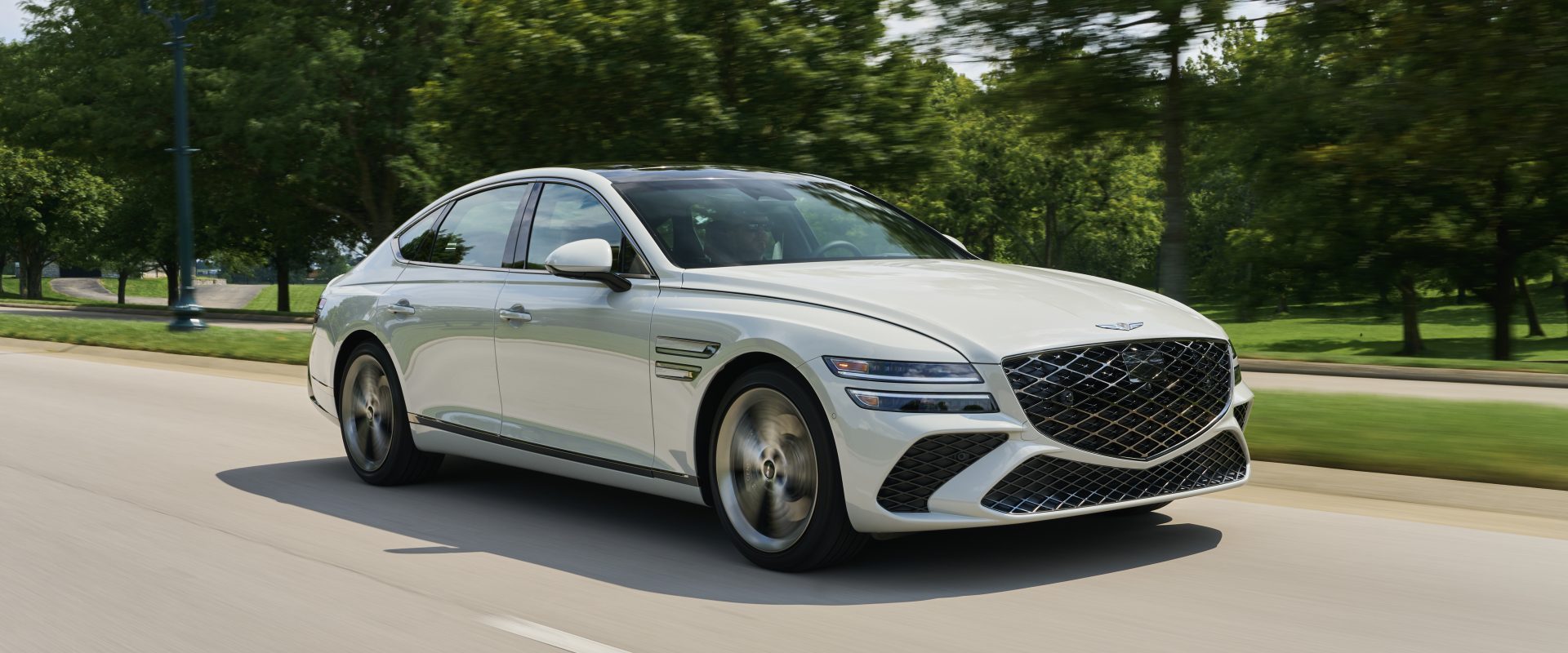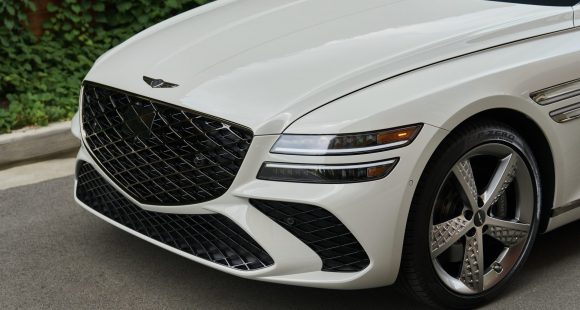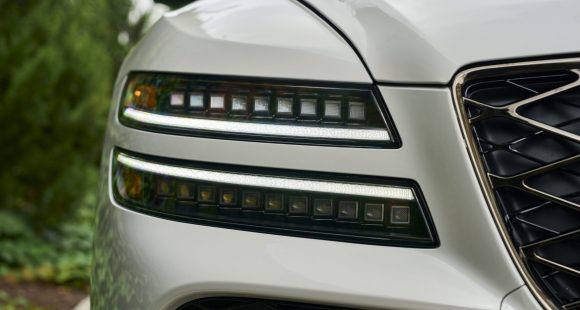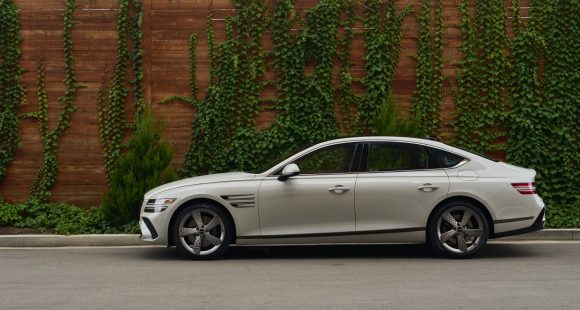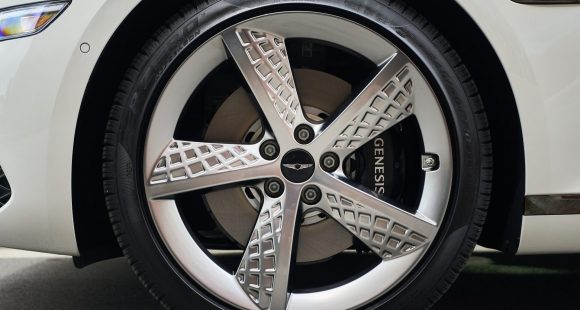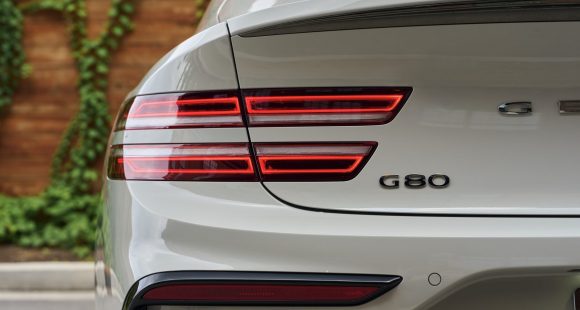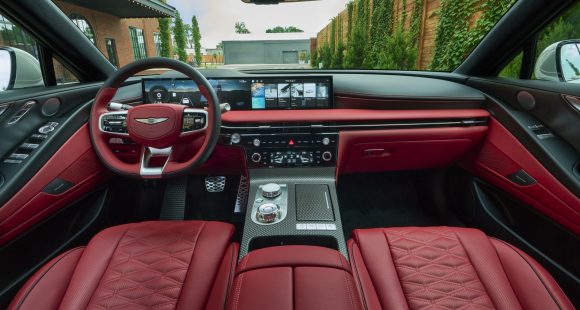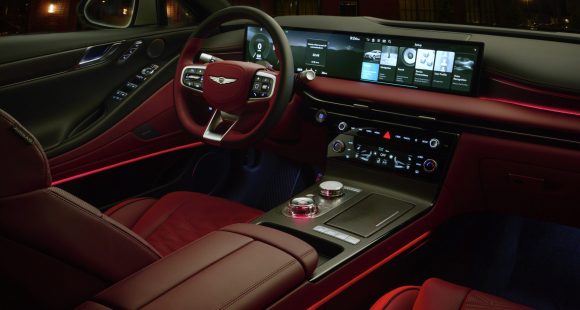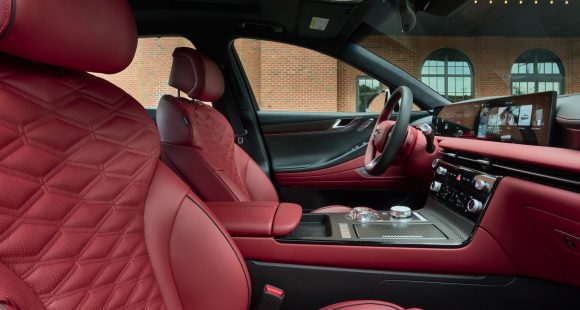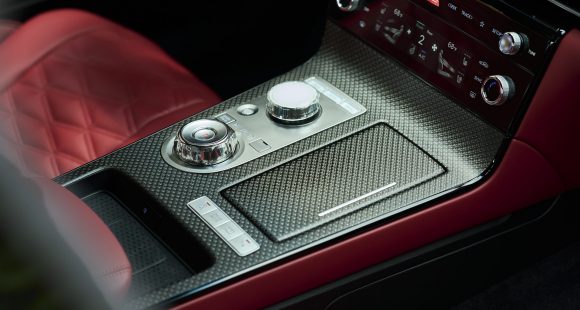2014 Chevrolet Corvette Stingray
You’ve seen the pictures, read all of the specs and claims, and even heard a few gripes as well. But now it’s time for our take on what the all-new Chevrolet Corvette is all about. And it really comes down to only one question. Does this 7th generation of America’s original sports car, and the reincarnation of the classic Stingray, have what it takes to go head to head with the world’s best?
No slew of photos or videos, or thoughtful first impressions, and certainly not knee-jerk blogs, can prepare you for the experience of getting behind the wheel for seat time in the 2014 Chevrolet Corvette Stingray.
Simply put, driving the new Corvette Stingray delivers far more excitement and satisfaction than even we were expecting. But before we get too far ahead ourselves, let’s take a look at the numbers that make this 7th generation ‘Vette such an incredible piece of work.
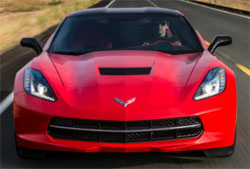 High tech has certainly arrived under the hood, but don’t think overhead cams; think Digital Direct Fuel Injection, Continuously Variable Valve Timing, and Cylinder Deactivation. All helping this new 6.2-liter small block LT1 V8 crank out 455-horsepower and 460 lb-ft. of torque. Making this the most powerful standard ‘Vette ever. But, smart buyers are spending the few extra bucks for the Performance Exhaust to boost those numbers 5 more to 460 and 465.
High tech has certainly arrived under the hood, but don’t think overhead cams; think Digital Direct Fuel Injection, Continuously Variable Valve Timing, and Cylinder Deactivation. All helping this new 6.2-liter small block LT1 V8 crank out 455-horsepower and 460 lb-ft. of torque. Making this the most powerful standard ‘Vette ever. But, smart buyers are spending the few extra bucks for the Performance Exhaust to boost those numbers 5 more to 460 and 465.
Yes we know there are plenty of cars with higher ratings, but few deliver their power this nastily, and we mean that in the best possible way. Launch control is on hand, but most drivers will be able to get better times without it, just 3.8-seconds to 60 if you nail it just right.
After that full-on brutal launch, it feels like this Corvette is not going to be that gentle everyman’s, easy to drive sports car of yore, but it still is. The steering is perfect in every way, quick and direct with great feel. On top of that, the wheel itself has gotten smaller and fits our hands perfectly.
Now let’s take a breath and look at this beautiful beast. There are no rough edges to its looks. Evolutionary? Sure! But, also very much world class with an intoxicating supercar-like blend of exotic stance, beautiful curves, sharp lines, and sheer aggression. There are vents galore, and they all work!
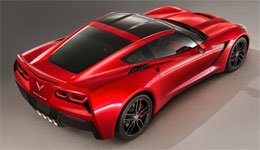 Much ballyhoo has been made over the Camaro-like taillights. Well, they are not nearly as objectionable in person as in photos. They’re here; they’re not round, so deal with it! We’d rather admire the artful center grouped quad-exhaust. Or the beefy rolling stock that comes with the Z51 performance package; 245/35/19’s up front, 285/30/20’s in the rear, with rubber by Michelin.
Much ballyhoo has been made over the Camaro-like taillights. Well, they are not nearly as objectionable in person as in photos. They’re here; they’re not round, so deal with it! We’d rather admire the artful center grouped quad-exhaust. Or the beefy rolling stock that comes with the Z51 performance package; 245/35/19’s up front, 285/30/20’s in the rear, with rubber by Michelin.
The Stingray has gotten wider and longer, but thankfully it feels much smaller behind the wheel. Engineering magic that other carmakers would love to duplicate. And even with more size, weight is held down with lots of aluminum and big panels of carbon fiber; for the hood, and the removable roof panel. The chassis is so stiff that you really feel one with the car.
We mentioned the wheels and tires of the Z51 Performance Package. Along with numerous upgrades, from dry sump oiling to bigger brakes, it ratchets up the Stingray’s feel and fun factor exponentially. No wonder 75% of early buyers are going for it.
But to us, Z51’s biggest benefit is the electronic rear differential. It’s seamless; constantly shifting power where it can be used most effectively, helping the Stingray as if it has earned a doctorate in grip.
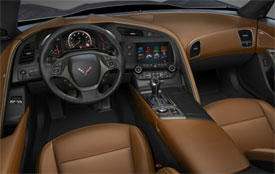 The interior is vastly better in layout and material quality. It’s still tight, but we’ll take it. There’s nicely done aluminum trim and, if you like, still more carbon fiber. Overall it’s top notch to see and touch.
The interior is vastly better in layout and material quality. It’s still tight, but we’ll take it. There’s nicely done aluminum trim and, if you like, still more carbon fiber. Overall it’s top notch to see and touch.
Even we’ve gotten tired of hearing ourselves complain about Corvette seats, and GM has finally put an end to that grievance. The standard buckets provide good fit and even better comfort. Thumb the start button, and there’s a nice bark, with an almost Italian flair, as everything comes to life.
Ratios for both the 7-speed manual and 6-speed automatic are just about spot-on. The manual is an absolute joy to work. And providing rev matching through steering wheel paddles is a welcome new twist. Magnetic Ride Control is available as before, but the range of firmness is broader, with the ride going from bone jarringly harsh to almost plush, while a standard drive mode system controls up to 12 vehicle attributes to further personalize your ride. All Stingrays also come equipped with Brembo brakes that work splendidly.
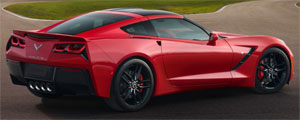 Despite all of the additional performance, Government Fuel Economy Ratings are up to 17-City, 29-Highway, and 21-Combined for manual equipped cars.
Despite all of the additional performance, Government Fuel Economy Ratings are up to 17-City, 29-Highway, and 21-Combined for manual equipped cars.
Corvette has long delivered the biggest high performance bang for the buck. But, you often got what you paid for. The C7 charts new territory and takes a backseat to no one in finesse. Still, $51,995 for this much performance should be pure fantasy land. And, that highly recommended Z51 Performance Package? Only $2,800 more.
To say that Chevrolet has got a real hit on their hands with the 2014 Corvette Stingray might just be the understatement of the year. And as much as we love the new look and giant leap forward in interior refinement, the best thing of all to us, is that it drives even better. Thoroughly modern, thoroughly bad-to-the-bone. The new Stingray! Consider us stung!
Specifications
- Engine: 6.2-liter
- Horsepower: 455
- Torque: 460 lb-ft.
- 0-60 mph: 3.8 seconds
- EPA: 17 mpg city/ 29 mpg highway
2025 Genesis G80
New Interior And New Tech Elevates G80 Sedan
Talk about bad timing. This second-generation G80 debuted at the height of a global pandemic. But that hasn’t stopped Genesis or this Bentley-on-a-budget sedan. In fact, since then, Genesis has unveiled a spectacular all-electric version and now given all G80s a makeover. So, let’s find out what a better and better-timed new G80 is ready to deliver.
Breaking into the luxury sedan scene requires going up against traditional brands with long pedigrees and legions of loyal buyers. But Hyundai has never shied away from a challenge, and has made steady progress with their Genesis brand, and hopes that a revised 2025 G80 midsize sedan will be their next step up.
Styling matters more when you’re the upstart, and the Genesis Athletic Elegance theme changes very little for ’25; just a new grille, slightly reshaped bumpers, new wheels ranging from 18 to 20 inches, and an updated color palette. The G80’s unique two-line LED headlamps get revised Micro Lens Array technology that boosts performance while minimizing the brightness for oncoming drivers.
Changes inside are much more significant with an entirely new dash and console, eliminating both the hooded gauge panel and dashtop wide info screen. Merging them together into one 27-inch wide LG panoramic display than runs from behind the steering wheel to over the center stack. There’s a bigger and more comprehensive control panel in the center stack; while the console gets less armrest coverage, more space for storage, and reshaped cupholders. The wider display is still a touchscreen, but there is also a console mounted controller if you prefer to keep it fingerprint free. Both options work well, but the controller is still too easy to confuse with the dial-like shifter.
Materials are on par if not a notch above most European luxury rivals, and there are 18 speakers to crank out 1,400 watts of premium sound from Bang & Olufsen. Top Sport Prestige trim comes with Nappa leather seats, carbon fiber trim, micro-suede materials for the headliner and pillar covers, heated armrests, head-up display, and upgraded active safety features. Front seats are immensely comfortable without feeling overly soft, and there’s plenty of comfort and room for adults in the back seat.
More Bentley than Benz; streaking down the track with European-style solidity that gives you very little indication of the high speed you’re traveling at.
Same powertrains as last year. Base power comes from a 300-horsepower 2.5-liter turbo-four; the upgrade is this 3.5-liter twin-turbo V6 that outputs 375 horsepower and 391 lb-ft of torque. Both are hitched to standard all-wheel drive. At our Mason Dixon Dragway test track, the AWD delivered enough grip for consistent slip-free launches. We hit 60 in 5.0 seconds flat. Run after run, the 3.5T pulled as strong as it sounds. All G80s work with the same paddle-shift eight-speed automatic transmission, and while shifting was silky smooth on the street, here on the track with Sport Mode and wide-open throttle they were noticeably firmer and quicker.
It was a very surreal experience in the cabin. More Bentley than Benz; streaking down the track with European-style solidity that gives you very little indication of the high speed you’re traveling at. For us, that was 105 mph in 13.4 seconds at the quarter. In addition to the G80’s Sport Mode that tightens steering, improves throttle response, adjusts shifting points, firms up the suspension, and reconfigures stability system parameters; Sport Prestige trim adds rear-wheel steering and an electronic limited slip differential. But, even with all of that, it didn’t feel overly sporty in our handling course. Now, we were able to comfortably carry quite a bit of speed through the cones, but there was just an overall soft, somewhat disconnected and heavy presence that had us unsure of how hard we could push. Sport Prestige also adds upgraded performance brakes. They were plenty capable, bringing this 4,600-lbs. luxury liner consistently down from 60 in just 104 feet with little fade.
Government Fuel Economy Ratings for the six-cylinder are 16 City, 24 Highway, and 19 Combined. We averaged a good 21.3 mpg of Premium. Still, that’s a slightly below average Energy Impact Score, using 15.7 barrels of oil annually with 7.8 tons of CO2 emissions.
Considering the amount of luxury packed into the G80, its $58,350 starting price, even though slightly higher than last year, remains pretty remarkable. It’s a substantial step up to the 3.5T though, as it begins at $70,850.
Genesis has existed as a standalone luxury brand for just less than a decade, and it has indeed been making steady progress into what is surely the hardest segment of all to master. The 2025 Genesis G80 sedan continues to impress and is a great option for luxury-minded buyers who prioritize true value over badges.
Specifications
As Tested
- Engine: 3.5-liter twin-turbo V6
- Transmission: eight-speed automatic
- Horsepower: 375
- Torque: 391 lb-ft
- EPA: 16 City | 24 Highway | 19 Combined
- 0-60 mph: 5.0 seconds
- 1/4 Mile: 13.4 seconds at 105 mph
- Braking, 60-0 (avg.): 104 feet
- MW Fuel Economy: 21.3 mpg (Premium)







